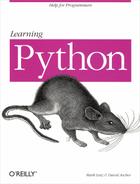Now that we’ve taken a first look, let’s fill in a few details behind Python’s exception model.
When you write
try
statements, a variety of clauses can
appear after the try statement block; Table 7.1 summarizes all the possible forms. We’ve
already seen most of these in the previous examples—empty
except clauses catch any exception,
finally runs on the way out, and so on. There may
be any number of excepts, but
finally must appear by itself (without an
else or except), and there
should be only one else in a
try.
The fourth entry in Table 7.1 is new.
except clauses can also provide a set of
exceptions to be caught, in parentheses; Python runs such a
clause’s statement block if any of the listed exceptions occur.
Since Python looks for a match within a given try
by inspecting except clauses from top to bottom,
the parenthesized version is like listing each exception in its own
except clause, except that the statement body
needs to be coded only once.
Here’s an example of multiple except clauses
at work. In the following, when an exception is raised while the call
to the action function is running, Python returns
to the try and searches for the first
except that catches the exception raised. It
inspects expect clauses from top to bottom and
left to right, and runs the statements under the first that matches.
If none match, the exception is propagated past this
try; the else runs only when no
exception occurred. If you really want a catch-all clause, an empty
except does the trick:
try:
action()
except NameError:
...
except IndexError
...
except KeyError:
...
except (AttributeError, TypeError, SyntaxError):
...
else:
...So far, our examples have used only a single try
to catch exceptions, but what happens if one try
is physically nested inside another? For that
matter, what does it mean if a try calls a
function that runs another try? Both these cases
can be understood if you realize that Python stacks
try statements at runtime. When an exception is
raised, Python returns to the most recently entered
try statement with a matching
except clause. Since each try
statement leaves a marker, Python can jump back to earlier
trys by inspecting the markers stack.
An example will help make this clear. The following module defines
two functions; action2 is coded to trigger an
exception (you can’t add numbers and sequences), and
action1 wraps a call to action2
in a try handler, to catch the exception. However,
the top-level module code at the bottom wraps a call to
action1 in a try handler too.
When action2 triggers the
TypeError exception, there will be two active
try statements—the one in
action1, and the one at the top level of the
module. Python picks the most recent (youngest) with a matching
except, which in this case is the
try inside action1. In general,
the place where an exception winds up jumping to depends on the
control flow through a program at runtime:
def action2():
print 1 + [] # generate TypeError
def action1():
try:
action2()
except TypeError: # most recent matching try
print 'inner try'
try:
action1()
except TypeError: # here only if action1 reraises
print 'outer try'
% python nestexc.py
inner tryWe’ve already talked about the
finally
clause, but here’s a more
sophisticated example. As we’ve seen, the
finally clause doesn’t really catch specific
exceptions; rather, it taps into the exception propagation process.
When used, a finally block is always executed on
the way out of a try statement, whether the exit
is caused by an exception or normal completion of the statements in
the try block. This makes
finally blocks a good place to code clean-up
actions (like closing files, as in the previous example).
The next code snippet shows finally in action with
and without exceptions. It defines two functions:
divide, which may or may not trigger a
divide-by-zero error, and tester, which wraps a
call to divide in a try/finally
statement:
def divide(x, y):
return x / y # divide-by-zero error?
def tester(y):
try:
print divide(8, y)
finally:
print 'on the way out...'
print '
Test 1:'; tester(2)
print '
Test 2:'; tester(0) # trigger error
% python finally.py
Test 1:
4
on the way out...
Test 2:
on the way out...
Traceback (innermost last):
File "finally.py", line 11, in ?
print 'Test 2:'; tester(0)
File "finally.py", line 6, in tester
print divide(8, y)
File "finally.py", line 2, in divide
return x / y # divide-by-zero error?
ZeroDivisionError: integer division or moduloNow, the module’s top-level code at the bottom calls
tester twice:
The first call doesn’t generate an exception (8/2 works fine), and the result (4) is printed. But the
finallyclause’s block is run anyhow, so you get theon the way outmessage.The second call does generate an exception (8/0 is a very bad thing to say). Control immediately jumps from the
dividefunction to thefinallyblock, and the message prints again. However, Python continues propagating the exception, which reaches the top level and runs the default exception action (a stack trace).
